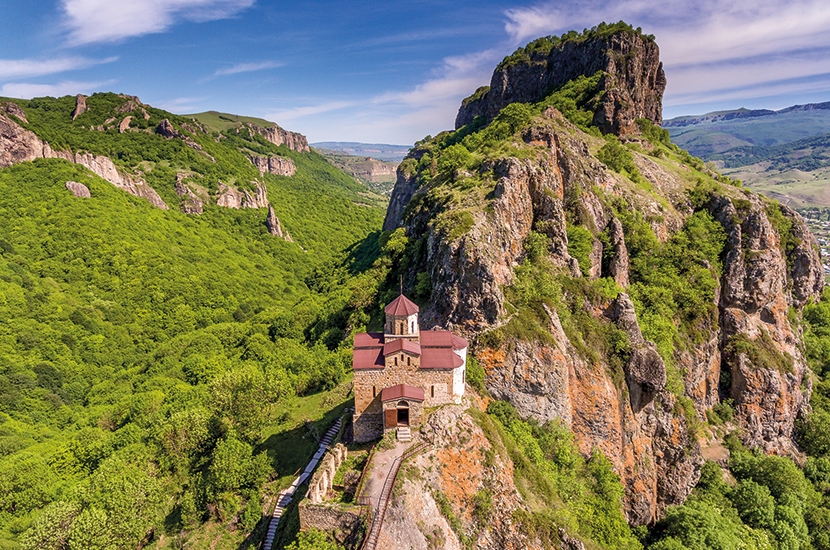The Caucasus, a popular saying goes, is a ‘mountain of tongues’. Describing this region requires a strong constitution, determination and brilliance because, as Christoph Baumer writes in this magnificent book, ‘in many ways, the Caucasus region is a puzzle’.
That is something of an understatement. For one thing, the mountains usually referred to as the Caucasus are in fact part of two geologically distinct ranges: the Greater Caucasus that is around 100 kilometers wide and 10 times the length, spans the land between the Black and Caspian Seas and acts as a climatic valve, blocking off like a plug cold Arctic air from passing south; and the Lesser Caucasus, that is considerably lower, easier to pass and about half the length of the range to the north.
That is just the start of it. Living within, between, on and near these mountain ranges are a range of peoples and cultures of such breathtaking diversity and such brilliant pasts that it is hard to know how best to explain their histories or where to begin. Two thousand years ago Pliny noted that 130 tribes lived in the Caucasus, and so to trade there one needed 130 interpreters. If you think he was joking then it is worth noting that the region is home to 60 languages today, drawn from six language families — South Caucasian; North-West Caucasian; North-East Caucasian; Indo-European; Altaic and Semitic.
Such complexity is a source of wonder. It also requires a narrative to explain why this region developed in the way that it is has, and why it has played such an important role in world history. Many examples can be given; but a casual and telling one is the fact that most white people in the world describe themselves (or are described) as being of Caucasian origin. Few stop to think about why that is the case, or even if it is not a little strange that we would trace our origins back to these mountain ranges to which we generally pay scant attention.
Fortunately, in Baumer, we have a guide who is fearless, compendious of knowledge and tireless in his efforts to set out the wonders of the past in this book, sometimes doing so valley by valley. He has done something similar before with distinction, most notably in four volumes on Central Asia that were highly well-researched, well-regarded and popular with readers.
Like those, this volume (the first of two) is lavishly illustrated. The images are magnificent, the stars of the show in fact — although they do not always correspond or relate to the accompanying text. Photographs of an Urartian deity dating back to the 8th century BC, of a relief of King Kvirike of Lori-Tashir and his brother King Smbat II from the side of the library of Haghpat monastery holding a model of the Holy Cross Church, or of the mountain fortress of Yernjak (Alinja) in Nakhchivan, Azerbaijan, are worth the price of the book alone. One could spend days admiring photos of the open city of Arshakavan or the many magnificent churches of the South Caucasus, and I would defy anyone who does so not to start looking into travel tours to see these sites in person if they have not already been lucky enough to do so.
Baumer’s text is wondrous; a feat of learning that covers the region from the formation of its landscape to the conquest of Armenia by the Seljuks in the late 11th century. It is studded with stories that reveal much about the survival instincts of the people — something that is perhaps not surprising, given that the first human ancestors to leave Africa made for the Dmanisi caves in what is now Georgia. Indeed, taken as a whole, the peoples of the Caucasus speak for extraordinary adaptability, resilience and ingenuity, as well as humankind in all its rich variety and difference.
Most readers will enjoy dipping in and out, rather than trying to take it all in. Even as someone who has spent decades working on this region, it can be exhausting keeping up with what often seems like the spinning plates act at the circus, as Baumer zips between kingdoms, principalities, client states and valleys to explain what is going on when and why. That owes something to necessity: in 428, for example, Persian Armenia split into 42 principalities, governed by 27 dynasties. That is a lot of stories, sometimes about the same thing, told in different ways.
But there are great riches here for the patient, as Baumer explains how the Armenian script was devised, how the drive to remain independent shaped religious policies that led to warnings from senior clerics that they had ‘heard a terrible rumor’ that ‘ravening wolves in sheep’s clothing’ had recently arrived: they meant that rival churchmen with differing interpretations of the scriptures had come to visit and wanted to warn off any rash decisions, including making friends. Coverage of Chalcolithic and Neolithic cultures, such as the Kura-Araxes and the Maikop-Novosvobodnaya respectively are particularly good — crisply written, informative and insightful.
This is a real treat: a rare book whose images do justice to the text and vice versa. I cannot recommend it highly enough.
This article was originally published in The Spectator’s UK magazine. Subscribe to the World edition here.


















